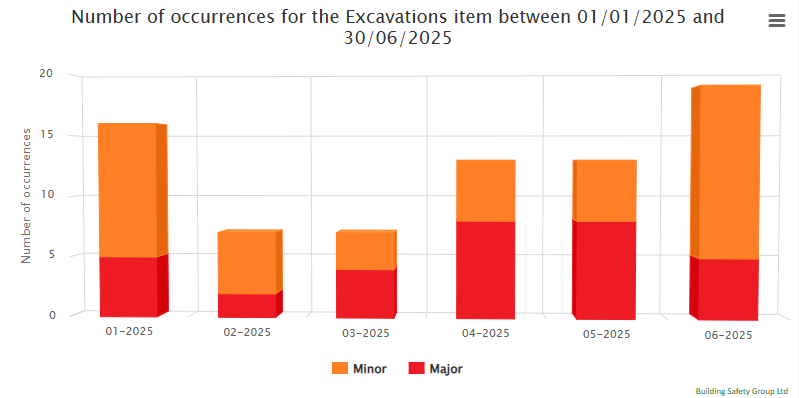09 October 2025
Excavation breaches increase by 50% on construction sites
The Building Safety Group (BSG) has reported a 50% increase in excavation breaches on construction sites. The report was based on 7,000 site inspections carried out during the first half of 2025, which compared Q1 with Q2.

BSG’s latest statistical analysis is a cause for concern as excavation work remains one of the most hazardous construction operations in the United Kingdom, with Health and Safety Executive (HSE) statistics indicating that collapses and related incidents account for numerous fatalities and serious injuries annually. Recent data shows that approximately 15% of construction-related deaths involve excavation accidents, highlighting the critical
importance of proper safety management in this high-risk activity.
Legal Framework and Compliance
Construction companies must adhere to stringent regulations, primarily the Health and Safety at Work Act 1974 and the Construction (Design and Management) Regulations 2015. These legislative frameworks mandate comprehensive risk assessments, proper planning, and implementation of safety measures for all excavation works.
Non-compliance can result in severe penalties, including substantial fines and potential imprisonment for serious breaches.
Common Hazards and their Mitigation
Ground collapse presents the most significant risk in excavation works. Soil conditions, particularly after rainfall or in areas with poor cohesion, can deteriorate rapidly. Recent cases have demonstrated that even seemingly stable excavations can fail catastrophically without warning. Underground services pose additional challenges, with struck utilities potentially leading to explosions, electrocution, or flooding.
To address these risks, construction companies must implement robust safety measures:
- Comprehensive site investigations, including detailed ground surveys and utility mapping
- Appropriate support systems such as shoring or battering
- Regular monitoring of ground conditions and support structures
- Clear demarcation of excavation zones with proper barriers and signage
Essential Safety Measures
Professional site investigation must precede any excavation work. This includes:
- Detailed ground surveys and soil analysis
- Underground utility mapping
- Implementation of appropriate support systems
- Installation of clear access and egress points
- Provision of adequate ventilation in deep excavations
Best Practices for Risk Management
Effective risk management requires:
- Daily inspections by competent persons
- Regular monitoring of support systems
- Clear communication protocols
- Comprehensive worker training
- Emergency response procedures
Emergency Preparedness
Sites must maintain:
- Rescue equipment readily available
- Trained first aiders on site
- Clear emergency procedures
- Direct communication links with emergency services
Conclusion
The dangers associated with excavation work demand unwavering attention to safety protocols. While implementing comprehensive safety measures may require significant investment, the cost pales in comparison to the potential human and financial consequences of accidents.
Construction companies must prioritise worker safety through proper planning, regular training, and strict adherence to safety protocols.
Companies should:
- Regularly review and update safety procedures
- Invest in proper equipment and training
- Maintain open communication channels with workers
- Foster a culture of safety awareness
BSG Recommendations
By following these guidelines and maintaining high safety standards, construction companies can significantly reduce the risks associated with excavation work while ensuring regulatory compliance and worker protection.
The investment in proper safety measures is not merely a legal requirement but a fundamental business imperative that protects both human life and company interests.
Useful Resources
405 Excavations-Buried Services – 2025.doc
406 Excavations-General – 2025.doc